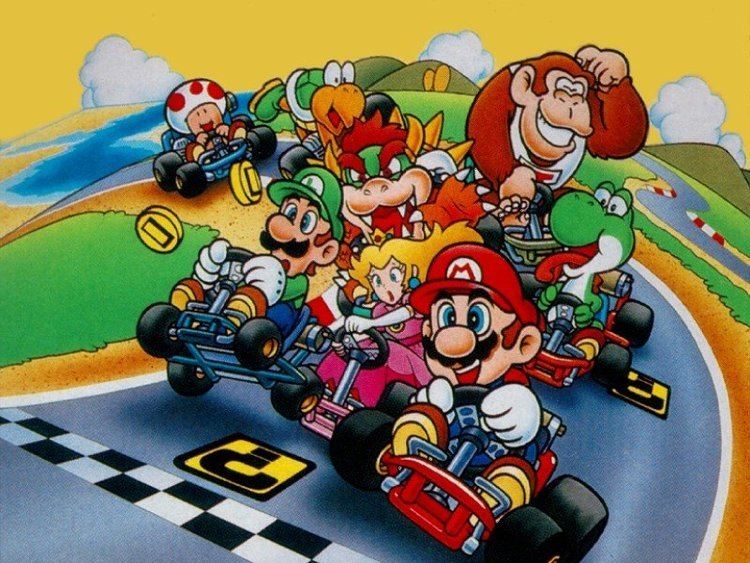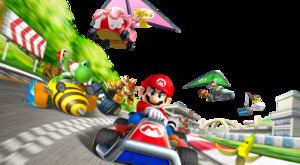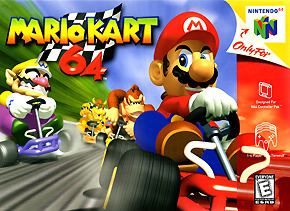Genres Racing | Genre Racing video game | |
 | ||
Developers Games | ||
Mario kart 7 gameplay nintendo 3ds capture card 60 fps
Mario Kart (マリオカート, Mario Kāto) is a series of go-kart-style racing video games developed and published by Nintendo as spin-offs from its trademark Super Mario series. The first in the series, Super Mario Kart, was launched in 1992 on the Super Nintendo Entertainment System to critical and commercial success.
Contents
- Mario kart 7 gameplay nintendo 3ds capture card 60 fps
- History
- Gameplay
- Courses
- Modes of play
- Console games
- Arcade games
- Other appearances
- Merchandise
- Reception
- References

There have been five Mario Kart games released for home consoles, three portable games, and three Namco co-developed arcade games, for a total of eleven. The latest title in the series, Mario Kart 8, was released on Wii U in May 2014. The series has sold over 100 million copies worldwide to date. An enhanced version of Mario Kart 8, entitled Mario Kart 8 Deluxe, will be released on the Nintendo Switch in April 2017.

History
The first title in the Mario Kart series is Super Mario Kart and was released for the Super Nintendo Entertainment System in 1992. The development of the first game was overseen by Shigeru Miyamoto, the Japanese video game designer who helped create the original Super Mario Bros., as well as many other successful games for Nintendo. Darran Jones of NowGamer suggests that the original success of Super Mario Kart was the result of including characters previously seen in Mario Bros. games, while also being a new type of racing game.
Gameplay
In the Mario Kart series, players compete in go-kart races, controlling one of a selection of characters from the Mario franchise. Up to eight characters can compete in each race, apart from Mario Kart Wii and Mario Kart 8. These two titles can include up to twelve-player racing.
One of the features of the series is the use of various power-up items obtained by driving into item boxes laid out on the course. These power-ups include mushrooms to give players a speed boost, Koopa Shells to be thrown at opponents, and banana peels that can be laid on the course as hazards. The type of weapon received from an item box is often random, though sometimes influenced by the player's current position in the race. For example, players lagging far behind may receive more powerful items while the leader will only receive small defensive items. Called rubber banding, this gameplay mechanism allows other players or computers a realistic chance to catch up to the leading player.
As the series has progressed, each new installment has introduced new elements in order to keep the gameplay fresh, such as new courses, items and playable characters. These changes include:
Courses
Many course themes recur throughout the series. Most are based on an existing area in the Mario franchise (Bowser's Castle being among the most prominent), but there are a number of courses that have not appeared elsewhere, but still belong in the Mushroom Kingdom, such as Rainbow Road. Each game in the series includes at least 16 original courses and up to 6 original battle arenas. Each game's tracks are divided into four "cups", or groups in which the player has to have the highest overall placing to win. Most courses can be done in three laps. The first game to feature courses from previous games was Mario Kart: Super Circuit, which contained all of the tracks from the original Super NES game. Starting with Mario Kart DS, each entry in the series has featured 16 "nitro" (courses belonging to its own game) and 16 "retro" tracks (courses from previous Mario Kart titles), spread across four cups each with four races. In Mario Kart 8, 16 additional tracks are available across two downloadable packages, eight for each package downloaded, including seven retro courses, four original courses, and five courses based on other Nintendo franchises, including Excitebike, F-Zero, The Legend of Zelda, and Animal Crossing.
Modes of play
Each installment features a variety of different modes. The following four modes recur most often in the series:
Console games
Arcade games
At one point, there was also a game in the series planned for the Virtual Boy in 1995. Tentatively entitled VB Mario Kart, it was likely to be the first sequel to Super Mario Kart. The game was cancelled due to the Virtual Boy's failure, but was revealed in a 2000 issue of German gaming magazine The Big N.
Other appearances
Several Mario Kart-related items appear in the Super Smash Bros. series, with Super Smash Bros. Brawl in particular featuring a Mario Circuit stage based on Figure-8 Circuit from Mario Kart DS, Super Smash Bros. for Nintendo 3DS featuring a Rainbow Road stage based on its appearance in Mario Kart 7, and Super Smash Bros. for Wii U featuring a Mario Circuit stage based on its appearance in Mario Kart 8, along with the returning Mario Circuit stage from Brawl.
Certain courses from the series have also appeared in F-Zero X, Fortune Street, the Mario & Sonic series, and Paper Mario: Color Splash. Various items from the series can also be seen in games such as Nintendogs and Animal Crossing.
Merchandise
The Mario Kart series has had a range of merchandise released.
Among them are a slot car racer series based on Mario Kart DS, which comes with Mario and Donkey Kong figures, while Wario and Luigi are available separately. A line of radio-controlled karts have also been marketed, with are controlled by Game Boy Advance-shaped controllers, and feature Mario, Donkey Kong, and Yoshi. There are additional, larger karts that depict the same trio and are radio-controlled by a GameCube-shape controller.
Japanese figurines of Mario, Luigi, Peach, Toad, Yoshi, Wario, Donkey Kong, and Bowser are also available for purchase as well as for Mario Kart 64, figures of Mario, Luigi, Wario, Bowser, Donkey Kong, and Yoshi were made by Toybiz. There are also Sound Drops inspired by Mario Kart Wii with eight sounds from the game. A land-line telephone featuring Mario holding a lightning bolt while seated in his kart, has also been marketed.
K'Nex released Mario Kart Wii sets, with Mario, Luigi, Yoshi, Donkey Kong, and Bowser in karts and bikes, as well as tracks from the game. Mario Kart 7 and Mario Kart 8 K'Nex sets have also been released.
Nintendo's own customer rewards program Club Nintendo released merchandise from the series as well. These include a Mario Kart 8 soundtrack, a Mario Kart Wii-themed stopwatch, and gold trophies modeled after those in Mario Kart 7. Before Club Nintendo, a Mario Kart 64 soundtrack was offered by mail.
In 2014, McDonald's released Mario Kart 8 toys with Happy Meals. They featured eight of the characters in karts that were customizable with stickers.
Reception
The Mario Kart series has received acclaim from both critics and fans. Nintendo Power listed the series as being one of the greatest multi-player experiences, citing the diversity in game modes as well as the entertainment value found.
Guinness World Records listed six records set by the Mario Kart series, including "First Console Kart Racing Game", "Best Selling Racing Game" and "Longest Running Kart Racing Franchise." Guinness World Records ranked the original Super Mario Kart number 1 on the list of top 50 console games of all time based on initial impact and lasting legacy.
The series has sold over 100 million copies. Mario Kart Wii is the best selling installment in the series, selling 36.38 million as of June 2015.
